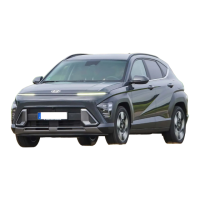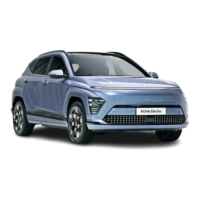6
6-37
Anti-Lock Brake System (ABS)
Anti-Lock Braking System (ABS) or
Electronic Stability Control (ESC) system
does not prevent accidents due to
improper or dangerous driving
maneuvers. Even though vehicle control
is improved during emergency braking,
always maintain a safe distance between
you and objects ahead of you. Always
reduce the vehicle speed in extreme road
conditions.
The braking distance for vehicles
equipped with ABS or ESC may be longer
than for those without these systems in
the following road conditions:
• Rough, gravel or snow-covered roads.
• On roads where the road surface is
pitted or has different surface height.
• Tire chains are installed on your vehicle.
Never test the safety features of an ABS or
ESC equipped vehicle by high speed
driving or cornering. It may cause a
collision and endanger the safety of
yourself or others.
ABS is an electronic braking system that
helps prevent a braking skid. ABS allows
the driver to steer and brake at the same
time.
Using ABS
To obtain the maximum benefit from your
ABS in an emergency situation, do not
attempt to modulate your brake pressure
and do not try to pump your brakes.
Depress your brake pedal as hard as
possible.
When you apply your brakes under
conditions that may lock the wheels, you
may hear sounds from the brakes, or feel
a corresponding sensation in the brake
pedal. This is normal and it means your
ABS is active.
ABS does not reduce the time or distance
it takes to stop the vehicle.
Always maintain a safe distance from the
vehicle in front of you.
ABS does not prevent a skid that results
from sudden changes in direction, such
as trying to take a corner too fast or
making a sudden lane change. Always
drive at a safe speed for the road and
weather conditions.
ABS cannot prevent a loss of stability.
Always steer moderately when braking
hard. Severe or sharp steering wheel
movement can still cause your vehicle to
veer into oncoming traffic or off the road.
On loose or uneven road surfaces,
operation of the anti-lock brake system
may result in a longer stopping distance
than for vehicles equipped with a
conventional brake system.
The ABS ( ) warning light stays on for
several seconds after the Engine
Start/Stop button is in the ON position.
During that time, ABS goes through
self-diagnosis and the light goes off if
everything is normal. If the light stays on,
contact an authorized HYUNDAI dealer as
soon as possible.
Hyundai_SX2_en_US.book Page 37

